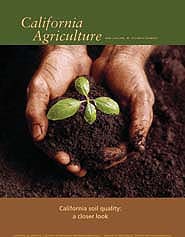All Issues

California soil quality: a closer look
Cover:
Soil is the essential building block for sustainable agriculture and healthy ecosystems. In this issue, UC scientists examine how production agriculture, natural vegetation, and environmental regulation have effected California soil. One study finds that the state's soil has maintained its chemical quality over the last six decades, although erosion appears to have accelerated. Scientists working in oak woodlands report that blue oaks signifcantly enhance the fertility of the soil. Others performing field trials in the Salinas Valley assess the trade-offs of different cultural practices. In addition, researchers provided helpful information to rice growers incorporating rice straw into soil, and to managers seeking to meet environmental regulations while using public lands to graze livestock.
April-June 2003
Volume 57, Number 2
Volume 57, Number 2





